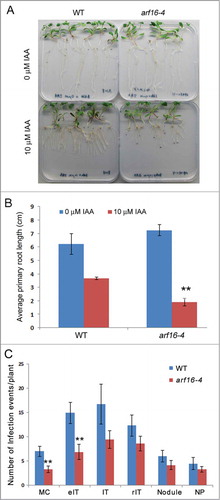Figures & data
Figure 1. Auxin response and nodulation phenotype of M. truncatula arf16a-4 mutant. (A) and (B) The inhibition of primary root growth by 10µM indole acetic acid in the wild type (R108) and arf16a-4 (NF4811). The picture (A) and histograms (B) show plants 14 d after germination. (C) Quantification of different stages of infection and development of nodule primordia in the wild type and arf16a-4 mutants 7 dpi with S. meliloti. Infection events and nodule primordia were scored 7 dpi with S. meliloti 1021 carrying pXLGD4 (LacZ) after LacZ staining. IT, fully elongated infection thread in root hair; eIT, elongating infection thread in root hair; MC, microcolony; rIT, ramified infection thread in cortex; NP, nodule primordium. Bar = SE. Significant (Student's t-test) differences between the wild type and mutant are marked with asterisks (**P < 0.01).

Table 1. Regulation of cytokinin-related genes in isolated root hairs in response to rhizobial inoculation and application of Nod factors (NFs)
